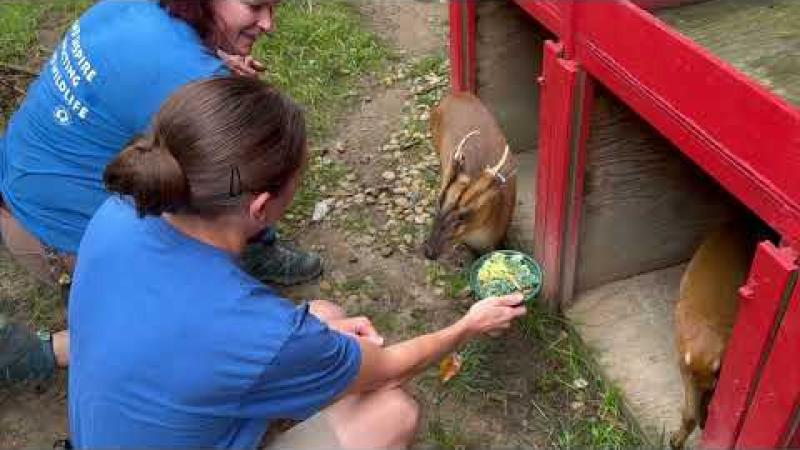Training is an important part of animal care at the Columbus Zoo and Aquarium! Our expert staff works closely with the animals to train them on various behaviors to better help us provide them with the best care. During these bi-monthly segments, we will focus on one training behavior and how different animals around the Zoo demonstrate it.
For this month’s Training Tales, we’re showcasing injection behavior. As you watch the video, you will see a number of our keepers training the animals to accept voluntary injections. Just like us, animals need to receive vaccinations throughout the year through our preventative health program at the Zoo. Each animal is trained to enter a chute or position their bodies close to the mesh to allow our keepers to administer their vaccinations voluntarily. Similar to our target training, when the animal allows our keepers to apply pressure with the needle, the keeper sounds the “bridge” which lets the animal know they did what the keepers wanted them to do. The animal is then rewarded with their diet or something else the animal may find motivating.
As you probably guess, getting any animal to sit still long enough and then to allow a keeper to press with a needle takes hard work and trust between the keeper and the animal. Most keepers start the process by getting the animal familiar with the situation where the injection will take place and then rewarding them when they hold that position for a few seconds. The time slowly gets longer and longer and the animal learns to hold the behavior for a longer duration until they hear the bridge and receive their reward. Eventually, the keepers will start desensitizing the animal to touch and slowly apply more pressure. Finally, the keeper will begin poking the animal with a capped needle or a blunted needle (point filed down) and reward the animal when the animal allows this. Through the training process and dedication from our keepers, by the time the real injection comes around, the animals become so familiar with the process that they barely react!
By watching the video, you may get an appreciation for the number of animals our keepers have been able to train for voluntary injections. It doesn’t matter if the animal is big or small, young or old, we view this as one of the primary behaviors that we like all of the animals to be trained for. We have been able to expand on this on a couple of occasions. Sea lion, Bodega, needed treatment for rear flipper mobility issues, and one possible solution was acupuncture. Keepers were able to build on his established injection behavior and perform multiple sessions of acupuncture on top of his other treatments. The good news is that this paid off with Bodega regaining some mobility in his rear flippers.
Another case of voluntary injections involved the polar bears in our care. The Polar Bear Species Survival Plan® (SSP) along with CREW (Conservation and Research of Endangered Wildlife) at the Cincinnati Zoo & Botanical Garden, decided that Anana and Aurora would be good candidates for artificial insemination. To prepare for this procedure, both girls needed to receive multiple hormone injections to ensure they were ovulating during the appropriate time for the procedure. This took trust between the keepers and the bears because they received multiple injections over a couple of weeks to allow everything to be set for the procedure. We are hopeful this will pay off this fall with the hope of being the first zoo to have cubs born through artificial insemination.
Thanks for joining us for Training Tales! But, the training at the Zoo doesn’t stop here–we still have more incredible behaviors to share. Be sure to stop back in November to see what else these amazing animals can do.










